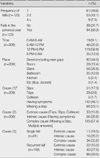Abstract
Purpose
The purpose of this study was to investigate the factors that increase of the risk for falls in low-income elders in urban areas.
Methods
The participants were elderly people registered in one of public health centers in one city. Data were collected by interviewing the elders, assessing their environmental risk factors, and surveying relevant secondary data from the public health center records. For data analysis, descriptive statistics and multiple logistic regression were performed using SPSS version 14.
Results
Stroke, diabetes, visual deficits, frequency of dizziness, use of assistive devices and moderate depression were statistically significant risk factors. The comorbidity of chronic diseases with other factors including depression, visual deficit, dizziness, and use of assistive devices significantly increased the risk of falls. From multiple logistic regression analysis, statistically significant predictors of falls were found to be stroke, total environmental risk scores, comorbiditiy of diabetes with visual deficits, and with depression.
Conclusion
Fall prevention interventions should be multifactorial, especially for the elders with stroke or diabetes, who were identified in this study as the high risk group for falls. A fall risk assessment tool for low-income elders should include both the intrinsic factors like depression, dizziness, and use of assistive devices, and the extrinsic factors.
References
1. Berg KO, Maki BE, Williams JI, Holliday PJ, Wood-Dauphinee SL. Clinical and laboratory measures of postural balance in an elderly population. Archives of Physical Medicine and Rehabilitation. 1992. 73:1073–1080.
2. Biderman A, Fried C, Galinsky D. Depression and falls among community dwelling elderly people: A search for common risk factors. Journal of Epidemiology and Community Health. 2002. 56:631–636.
3. Ciechanowski PS, Katon WJ, Russo JE. Depression and diabetes: Impact of depressive symptoms on adherence,function, and costs. Archives of Internal Medicine. 2000. 160:3278–3285.
4. Consumer Safety Department. survey on the safety accidents of elderly. 2007. Seoul: Korea Consumer Agency.
5. Fleming BE, Pendergast DR. Physical condition, activity pattern, and environment as factors in falls by adults care facility residents. Archives of Physical Medicine Rehabilitation. 1993. 74:627–630.
6. Ganz DA, Bao Y, Shekelle PG, Rubmenstein LZ. Will my patient fall? The Journal of the American Medical Association. 2007. 297:77–86.
7. Iwarsson S, Horstmann V, Carlsson G, Oswald F, Wahl HW. Person-environment fit predicts falls in older adults better than the consideration of environmental hazards only. Clinical Rehabilitation. 2009. 23:558–567.
8. Jang IS, Kim SM. A study on risk factors of injuries from fall experienced by home-staying elders in a provincial area. Journal of Korean Gerontological Nursing. 2006. 8:107–116.
9. Jeon SJ, Kimgang MJ, Park JS, Lee MH. Adult health nursing. 2005. Seoul: Hyunmoonsa.
10. Jeong KH, Oh YH, Suk JE, Do SL, Kim CW, Lee YK, et al. The nationwide survey of elderly' living and desire for welfare in 2004. 2005. 03. Seoul: Korea Institute for Health and Social Affairs.
11. Josephson KR, Fabacher DA, Rubenstein LZ. Home safety and fall prevention. Clinics in Geriatrics Medicine. 1991. 7:707–731.
12. Kee BS. A preliminary study for the standardization of geriatric depression scale short form-Korea version. Journal of Korean Neuropsychiatric Association. 1996. 35:298–307.
13. Kim CY, Kim SM. RAI-HC assessment manual verson 2.0 in Korean by inter RAI. 2000. Seoul: Korea Medical Consulting Co.
14. Kim DH. Elderly dizziness. Journal of the Korean Academy of Family Medicine. 1999. 20:549–555.
15. Lee BD, Dong JU. A study on the improvement projects of resident environment in the poor residence for low income families in inner city. Journal of Korean Academy of Community Development. 2005. 30:91–103.
16. Lord SR, Menz HB, Sherrington C. Home environment risk factors for falls in older people and the efficacy of home modifications. Age Ageing. 2006. 35:Supple 2. ii55–ii59.
17. McAllister A. Fall injury prevention for older adults and those who care about them. 2007. Lincoln, NE: iUniverse, Inc.
18. Elderly health and social welfare service guideline. Ministry of Health and Social Welfare. 2004. from http://www.mw.go.kr/front/jc/sjc0106mn.jsp.
19. Moon YH. The prevalence and associated factors of the in-home falls of the elderly. Journal of Korean Academy of Public Health Nursing. 2005. 19:249–260.
20. Park SI, Kim TW. Poverty and income distribution. Health and Welfare Policy Forum. 2000. 41:17–25.
21. Rubenstein LZ, Josephson KR. Falls and their prevention in elderly people: What does the evidence show? The Medical Clinics of North America. 2006. 90:807–824.
22. Shin YS, An YY. Methodology for medical science. 1997. Seoul: Seoul National University Publishing.
23. Tromp AM, Smit JH, Deeg DH, Bouter LM, Lips P. Predictors for falls and fractures in the Longitudinal Aging Study Amsterdam. Journal of Bone and Mineral Research. 1998. 13:1932–1939.
24. Vassallo M, Stockdale R, Sharma JC, Briggs T, Allen S. A comparative study of the use of four fall risk assessment tools on acute medical wards. Journal of the American Geriatrics Society. 2005. 53:1034–1038.
25. Won JS, Kim KH. Evaluation of cognitive functions, depression, life satisfaction among the elderly receiving visiting nursing services. Journal of Korean Academy of Nursing. 2008. 38:1–10.
26. Yesavage JA, Brink TL, Rose TL, Lum O, Huang V, Adey M, et al. Development and validation of a geriatric depression screening scale: A preliminary report. Journal of Psychiatric Research. 1983. 17:37–49.
27. Yi GM, Kim EY, Kim HG, Park EO, So AY, June KJ. A study of environmental hazards in the homes of older people. Journal of the Korea Gerontological Society. 2001. 21:179–190.
28. Yoo IY. Fall and housing environmental problem of the couple and single elderly. Journal of the Korean Society of Living Environmental System. 2005. 12:199–205.
29. Yoo IY, Choi JH. Experience and predictors of falls in the elderly at senior citizens' centers. Journal of Korean Academy of Community Health Nursing. 2007. 18:14–22.




 PDF
PDF ePub
ePub Citation
Citation Print
Print






 XML Download
XML Download